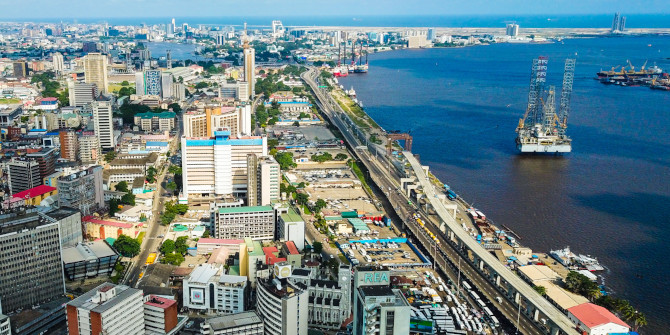In his first address to the United Nations as US President on 21 September, Joe Biden called for unity amid tensions between the US and its European allies. But do these tensions spell the end of ‘the West’? Drawing on a new book, Jussi Hanhimäki asks whether the rollercoaster-like evolution of the transatlantic relationship is in fact an indication of the strong bonds that hold the West together.
There is no hope. Wherever you look, it appears patently obvious that the ‘West’ has been caught in a downward spiral. Take the state of NATO. The alliance is experiencing a severe identity crisis, prompted by internal squabbles and external circumstances. Questions about fair burden-sharing and defence spending have been accentuated by disparaging comments from leaders like former US President Donald Trump and his French counterpart Emmanuel Macron. The former repeatedly called the alliance ‘obsolete’; the latter in 2019 referred to its ‘brain death.’ Meanwhile, the 2014 Russian annexation of Crimea seems to have emboldened Vladimir Putin’s quest to expand Moscow’s influence.
Joe Biden’s mantra – ‘America is back’ – has apparently done little to reverse the inevitable decline of the West. If anything, NATO appears even more paralysed. It has collectively accepted – in practice if not as a policy – that post-Cold War enlargement has reached its geographical limits. Twenty years of out-of-area military interventionism (Iraq, Libya, Afghanistan) has yielded few positive results while sowing further tension between alliance members. The ignoble exit from Afghanistan is the icing on this particular cake. The collective security pact that has been the institutional embodiment of the post-World War II transatlantic partnership appears ready for retirement.
While NATO seems on its way out, the liberal international economic order is rapidly changing. The rise of China and other rapidly evolving economies seems bound to knock the United States off its number one spot and will likely dwarf the European Union – no longer able to count on the UK as part of the single market – in terms of GDP very soon. Meanwhile, Atlantic economic integration halted as the Trump administration pursued an ‘America First’ strategy and Britain exited the EU.
Then there is the persistent presence of populism and nationalism on both sides of the Atlantic. Trump, as the American President, was its most visible example. But his playbook was also noticeably similar to a number of political parties and movements across the transatlantic space from Italy to Finland, from the UK to Hungary. Rising nationalism undermines the work of multilateral institutions that symbolise the international system built and maintained via close transatlantic co-operation during and, most pertinently, after the Cold War.
Recent proof, if more is needed, about this dire state of transatlantic relations in the 21st century was the sudden global spread of Covid-19. Rather than increasing transatlantic cooperation in the face of a common threat, the immediate reaction in Europe and the United States was to close borders and turn inward. In the autumn of 2021, transnational cooperation – or working together via the World Health Organization – remains patchy at best.
Crises abound in the history of the transatlantic relationship. Still, the West endures. It is unlikely to unravel any time soon.
And yet. Dismal as all this seems, the ‘West’ is far from finished. In a new book, Pax Transatlantica, I argue that beneath and beyond the doomsday like rhetoric, the transatlantic space is more integrated today than at any time in the past. The post-Cold War era has been filled with transatlantic disagreements and crises. But it has also been a period of enlargement, deep economic ties, and shared political trends.
Consider the history of NATO. By 2021 its membership rota has almost tripled from the original twelve of 1949. Most of this growth has taken place since 1990 (with North Macedonia joining in 2020 as the 30th member state). The key to NATO’s longevity and growth? In part, it is the alliance’s adaptability to the changing international situation. But ultimately, it is the sense that in the third decade of the 21st century, NATO’s member states remain concerned by similar, if not identical, security challenges.
To be sure, the recent Taliban takeover of Afghanistan is likely to diminish the appetite for ‘out-of-area’ operations. But it has done nothing to change the basic reality: (most) Europeans feel more secure because of NATO, while the United States regards the alliance as an anchor of its overall grand strategy. Concerns about Russian actions and growing Chinese influence guarantees the continuation of transatlantic security interdependence.
Then there is the transatlantic economy. The big economic story of the post-Cold War era has been the relentless rise of the People’s Republic of China (PRC). Both the United States and the European Union (EU) buy more manufactured goods from the PRC than anywhere else. But that is only part of the story. Notwithstanding numerous rows about unfair trade practices and the rise of economic nationalism that have stalled the process of Atlantic integration, the North Atlantic space boasts the richest and most closely connected transcontinental economy in the world.
The United States and Europe are each other’s major export markets for goods. Transatlantic trade in services globally far outweighs the PRC’s limited role. Most important, there are massive investment flows between North America and Europe that, even as negotiations to create a Transatlantic Trade and Investment Partnership (TTIP) ground to a halt in 2016, continued unabated.
Lastly, consider the parallel evolution of domestic politics in the transatlantic space. Notably, much has been said and written about the threat that populism poses to the future of the West. The twin shocks of Brexit and Donald Trump’s election in 2016 prompted a virtual tsunami of pessimistic predictions of a divided and diminished West.
Yet, even in the realm of democratic politics one can find evidence for the ever closer integration of the North Atlantic region. Populism in the 2010s is not the only example of the parallel evolution of domestic politics on both sides of the Atlantic. The rise and fall of the so-called ‘Third Way’ in the 1990s and early 2000s was an early indication of how closely integrated the post-Cold War transatlantic political space already was. More recently, the pushback against populism has become a transatlantic phenomenon gaining momentum as a consequence of Covid-19 ‘denialism’ and vaccine hesitancy.
Crises abound in the history of the transatlantic relationship. Still, the West endures. It is unlikely to unravel any time soon.
For more information, see the author’s new book, Pax Transatlantica: America and Europe in the Post-Cold War Era (Oxford University Press, 2021)
Note: This article gives the views of the author, not the position of EUROPP – European Politics and Policy or the London School of Economics. Featured image credit: European Council





